When the third police car sped by the small children’s playground at the head of Harbor Road, lights flashing...
(I’ve changed the names of the individuals and the streets in this story to protect and respect the privacy of the great people of Avon Village – historically called “Kinnekeet Village”)
When the third police car sped by the small children’s playground at the head of Harbor Road, lights flashing, Bernadette turned to me and said calmly yet slyly, “that’s unusual.” Then an ambulance sped by. Bernadette turned away to watch its trajectory, her hand slowly running through her straight brown hair, pulling it between her shoulders, in slow motion, as if time had gotten stuck and that moment was progressing at half-speed. She then turned back, scanning the playground for her daughter as any watchful mother would do. Her daughter and mine were swinging on adjacent swings. She turned to me again and said, “that’s something, I guess. I haven’t seen that much activity for a while. We’re a sleepy little village here, we all know each other. Went to school together. Even after college they all come back.”
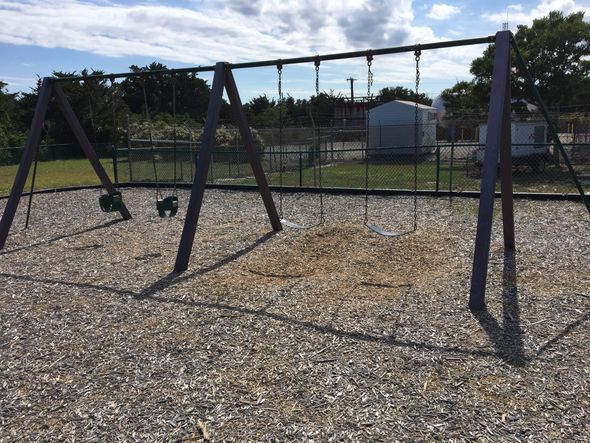
The children’s playground on Harbor Road, Avon Village, NC
I had crossed over Harbor Road from the north to the south to reach the playground, hand in hand with my own daughter. As we approached the gate Bernadette was speaking with a young person who I believe was her niece. As she spoke she turned towards me and without missing a beat she began speaking to me, as if we were old friends. It was as if she knew I was arriving and had planned her conversational pivot to meet me at a precise time. Bernadette has large dark-green doe eyes that have a drama to themselves. You can’t tell is she’s about to laugh or cry. As we talk about growing up in the village she turns her head in profile, running her fingers through her hair and taking a drag on a cigarette. She turns back to face me when she completes a sentence.
In the Village of Avon most of the home-owners live there all-year-round. Outside of the Village, it’s mostly tourists and rental properties. I asked her about living in Avon. She shrugged at first, and told me how she works a few jobs, and how it’s a quiet, but she’s doing what she can. She asked me where I was from, and when I answered she asked how close to the city I was. She thought it was great to live near the city. “You’ve been through Nags Head, that’s our city. Down here were have a Dollar General and Food Lion, but up there, there’s more to do.”
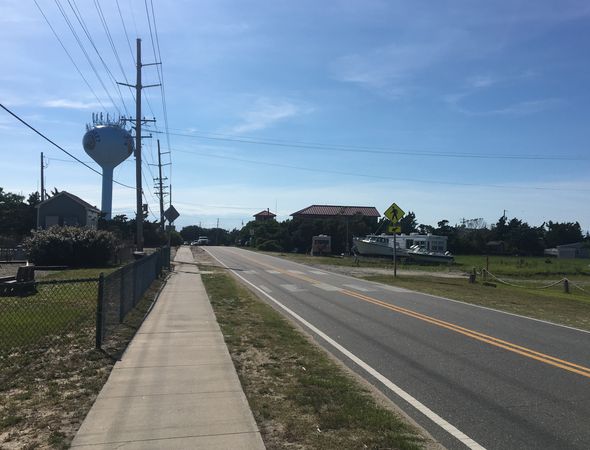
Harbor Road, looking west from Route 12. Water tower on the left.
Avon Village, Moated via a Canal
When you look at the Village on a map you’ll see it’s on the sound-side, with many inlets and canals that lead to the Pamlico Sound. The sound is about four feet deep for the four miles west as the crow files. Then there’s a reef, and then the water deepens to between 15 and 25 feet. Those westerly four miles of warm, clear waters allow for tranquil activities such as paddle boarding, kiteboarding (on windier days), canoeing, and jet skiing. Many who live on the sound-side have a small boat. There is also a lot of fishing.
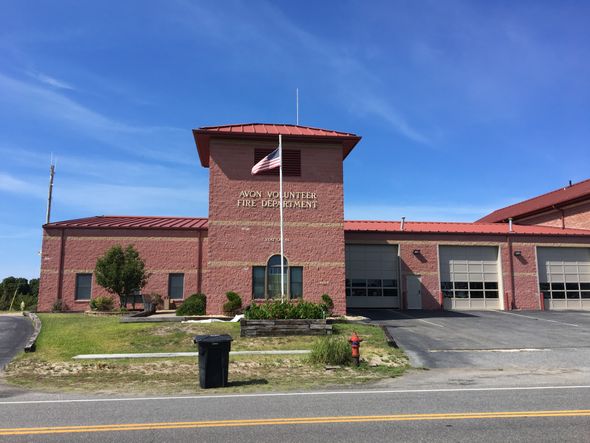
Avon Volunteer Fire Department.
If you spend some time studying the map, it becomes clear the Village is moated off from the rest of Avon. There’s a semi-circular canal, blocking all street access except for Harbor Road. Whether this was an intentional fortification or merely a way to give more of the Village access to the sound, there’s only one road in, or out, from the Village. Standing at the head of Harbor Avenue is like standing on the drawbridge. It’s the only place the water runs underneath your feet. The water tower, the fire station, the electric plant, and the playground line the entrance to the Village.

Avon Village is “moated” off from the remainder of Avon by a canal. Harbor Road, seen towards the middle-right of the map, acts as the “draw bridge” in and out of the village.
Meandering Through the Village via Harbor Road
Once you traverse fifty yards down Harbor Road, it cuts to the left, just past an intersection with one option on the right. The right turn is the only road to the Northern part of the village. If you meander up the appropriately titled “North End Road” the marshlands will be on your left, and occasionally you’ll see a cropping of “Live Oak” trees (”Live Oak” defines these Oaks are evergreen). The Live Oaks on Hatteras Island of the Outer Banks have multiple, winding branches, appearing like an ideal tree-climbers training-ground.
“The whole island was once covered in these Oak trees,” Robby begins to tell me as we sit on the dock at a local water-sports shop, his curly red hair pushing out from the edges of his baseball cap. Robby is the person you hope to meet when you visit a new town. Unassuming and a little off-putting at first, he’s actually a hoot, and it becomes clear he knows everybody and everything about the area. “You could climb from tree to tree, from the ocean to the sound, without ever touching the ground,” he relates dreamily when asked by one of the shopkeepers at the water-sports store if he’d like to live ‘back then.’ She then asks him if he knows about a secret group of people that live secretly in the pine forests.
“Sure,” he starts and pauses, as if relaying a campfire ghost story, but then brings it closer to reality, “I’ve seen camp grounds back there. If you park your car, jump the ditch and walk into the trees you’ll find a small wooden bridge, and paths. Some paths have bottles along it, soda bottles, that sort of thing, to mark the trail. I’ve never seen people though.”
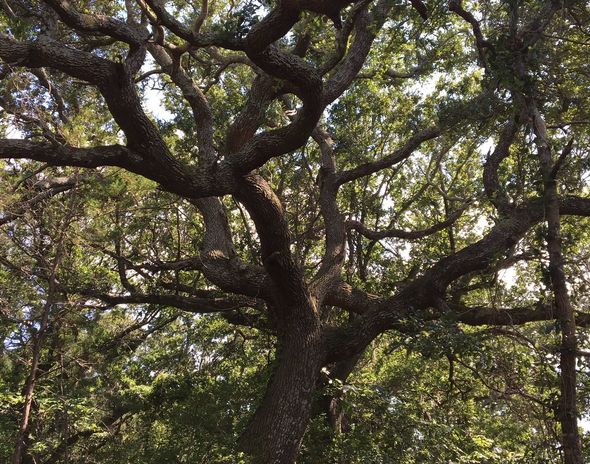
“Live Oak” tree.
The Outer Banks Survive
Though the Outer Banks are romantically referred to as “life a sandbar” on t-shirts, hats and mugs, the islands used to be foliage rich and sturdy against the sea. After the majority of the trees were cut down for commerce, mainly for shipbuilding, the islands became an unstable sandbar, with stories of “live” sand dunes roaming the island and suffocating the remaining forests and engulfing villages. It wasn’t until the 1930s and the New Deal when funds were provided to create the ocean-side miles of dunes and the planting of new foliage to hold them in place. Still, after nearly every Nor’Easter or Hurricane the islands need some form repairing, typically returning the high piles of sand the ocean pushed onto the main roads back to the beaches and dunes. In some case breaches need to be filled back in. In others, bridges need to be built.
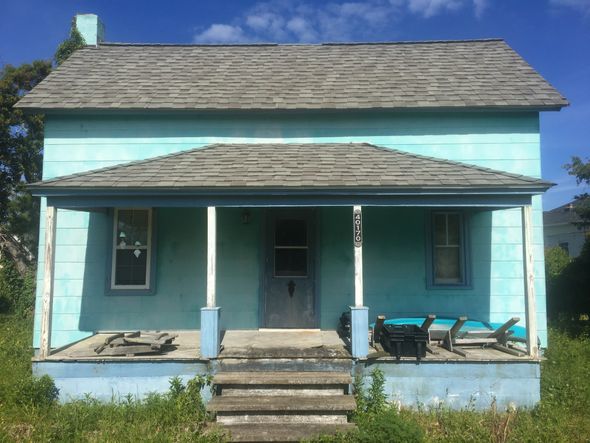
Older blue house in Avon Village.
Grave Sites Under Canopies of Live Oaks
It’s under the canopy of these remaining Live Oaks that you’ll find scattered grave sites, some going back to the 1800s. “Kinnekeet used to be 2 miles north of here,” Robby points north into the sunlight, his face covered in zinc oxide to protect it as he’ll be on the water all day, “sometime around the late 1800s they moved the entire town down here to the village. Higher ground. Guess they got tired of their homes flooding.”
“How’d they do that?” I asked sincerely.
“No idea,” Robby replied shaking his head slowly, lifting his hat, pushing his hair back with the palm of his hand and putting his hat back on, “No. Idea.”
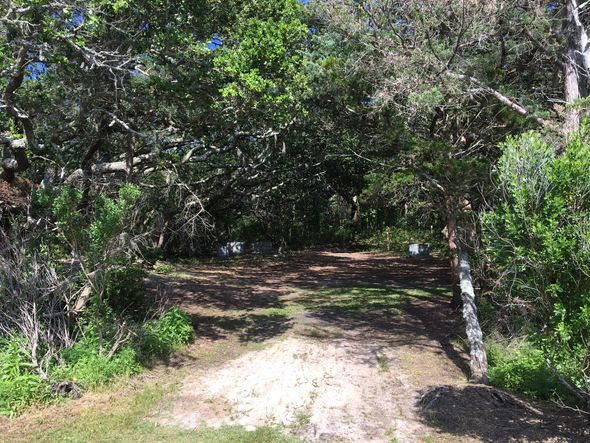
Unmarked entrance to a path to grave sites.
During my meandering I stumbled upon a shadowed trail among the Live Oaks. I stopped my bike, dismounted and tread carefully while reading the names on the grave markers. I realized that many of the street names in the village share their names with the deceased.
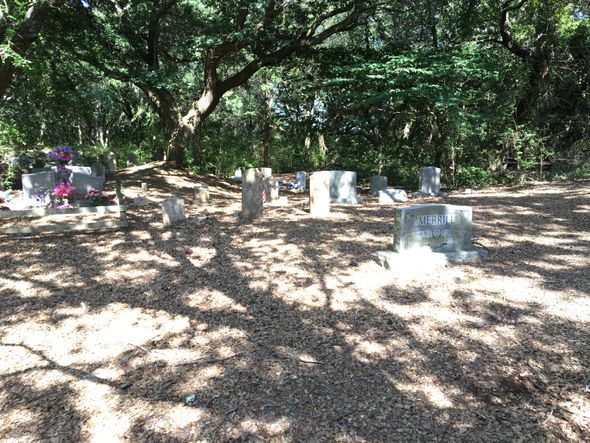
Grave sites under the canopy of Live Oaks.
I turned back, exited the cemetery, and headed south to reconnect with Harbor Road to visit the Harbor. It’s peacefully quiet in the village. Along the roads are a mix of historical homes and newer construction. Most of the new homes are built on stilts. As I biked along the road I barely noticed the folks quietly sitting on their porches. They were incredibly still. At nearly each house there was a person, sitting. gazing, resting. It’s quiet and tranquil in the Village.
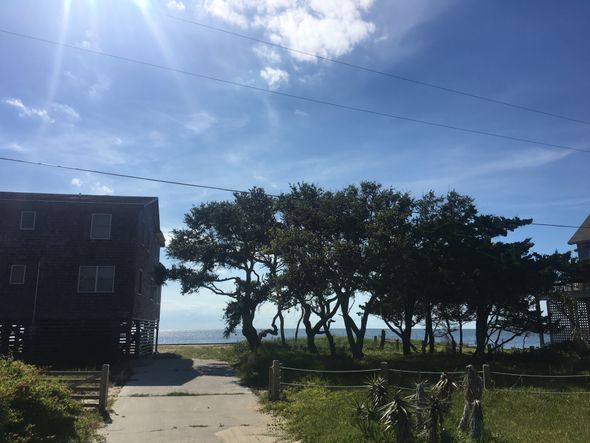
A newer home, built on stilts, sits on the edge of the Pamlico Sound. A cropping of Live Oaks are on the right.
Haunted House?
I made a short turn to my right, on Scarborough Road, recognizing the family name from a headstone. A sea gull stood as a sentinel in the middle of the road. It wouldn’t budge. As I rode my bike towards it, it lifted up with its wings spread, and flew right towards me until peeling off towards my left. I could feel the pushed air from its wings on my face and arms. It seemed to be protecting a home, long abandoned, peeking out from behind some overgrown bushes.
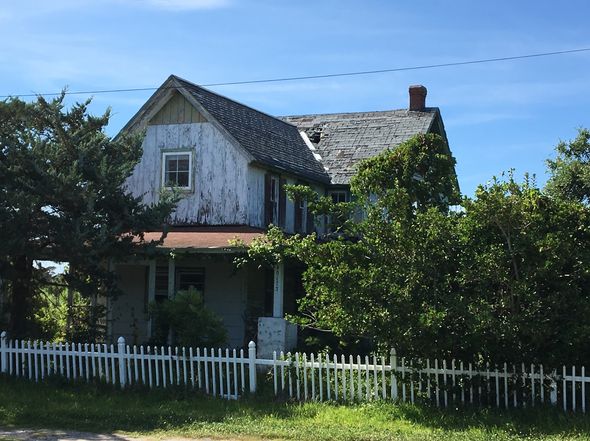
House on Scarborough road that was protected by the lone gull.
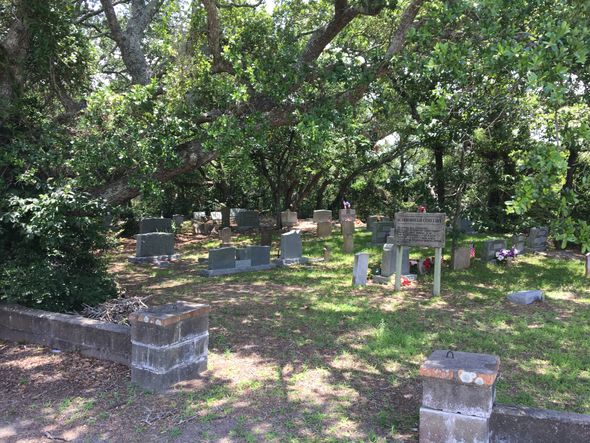
The Scarborough Cemetery.
A Sad Circumstance and the Empty Harbor
I turned back onto Harbor Road, and reached the harbor in a few minutes time, to find it too was abandoned, with “for sale” signs posted on its three core buildings. There was the scar of a former sign on the middle building for “Avon Seafood,” which was seemingly long-gone.
“Yeah, that’s been closed for a while,” Robby remarked, tussling his hair while leaning back on a wooden railing, “he would pay the fisherman way below cut price, and then mark up the cost of the fish for top dollar. The fishermen caught on, and that was it, he went out of business.”
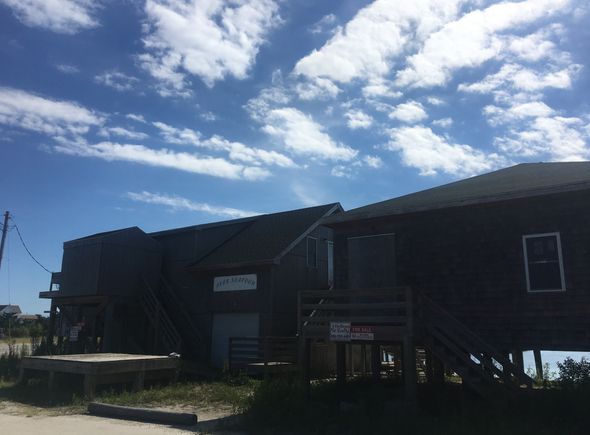
Former Avon Seafood at the Avon Harbor.
I asked Robby why the buildings were still empty in what appeared to be a vital part of the Village, “Well, it’s all caught up in red tape now. The guy who owned the market killed himself. Whoever ends up buying the harbor won’t gain possession of it for fifteen years or so.”
“I see,” I replied, surprised and somberly.
“Well, don’t be sad…did you know that land was originally a pasture and that they hand-dug the harbor,” Robby continued, shifting the conversation back towards something positive.
“Whoa,” I replied, thinking of all the labor it would take to hand dig a harbor back in the 1800s, though the thought of the former owner of the seafood store lingered in my mind.
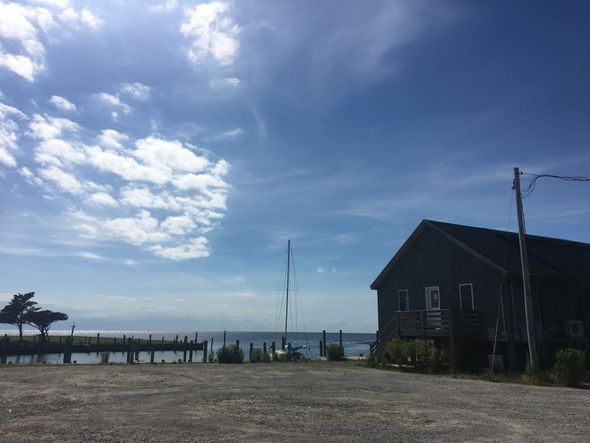
Avon Harbor, looking west towards the Pamlico Sound.
The News Breaks in the Playground
Later, about fifteen minutes after the police cars raced by while I was speaking with Bernadette, the news broke.
As the sun set and the sky grew darker, thousands upon thousands of magnificent stars emerged from the twilight. There were more stars than I could remember seeing. A young couple arrived, coming up the road from the Village. A young man was on his bike and a young woman was walking beside him. They saw Bernadette, the young man imperceptibly nodded, and they walked towards the playground gate.
“Overdose,” the young woman said frankly and excitedly, leaning her hand on the playground fence, but not entering. “I’m pretty sure it was Mary.”
“How you know?” Bernadette asked.
“Because they were headed down Smith street, and Mary’s the only one who lives down there that I know that could of overdosed.”
“Right,” Bernadette surmised, then turned towards the swings, “Ok, Kelly, time for us to go home.”
The Princess House
I thought back to when I was exploring the Village streets. I reached a dead-end on an empty street. There at the end was a “restored” house. It was pink and purple, partly victorian, partly other styles. It was remarkable, both for its detail and for its soleness. It could have been dropped out of the sky, or out of a fairy tale book.
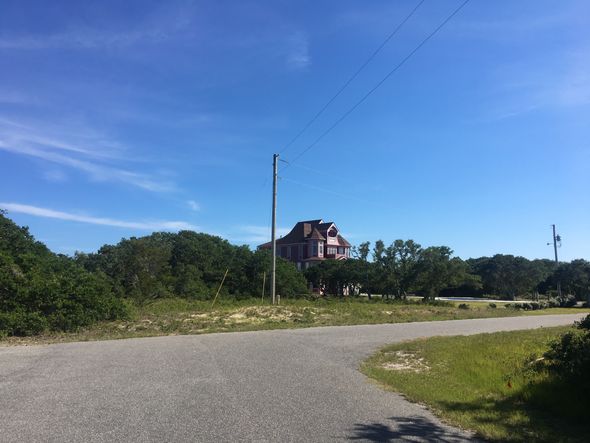
The “Princess House.”
“Oh, I know that house, “Robby acclaimed, “that lady has been fixing that house up for years. Importing fixtures from everywhere, custom woodworking. It’s a beautiful home.”
“Ah, that’s the ‘Princess House,’” Bernadette responded in a whisper when I asked her if she knew about that house, “at least that’s what my daughter calls it.”
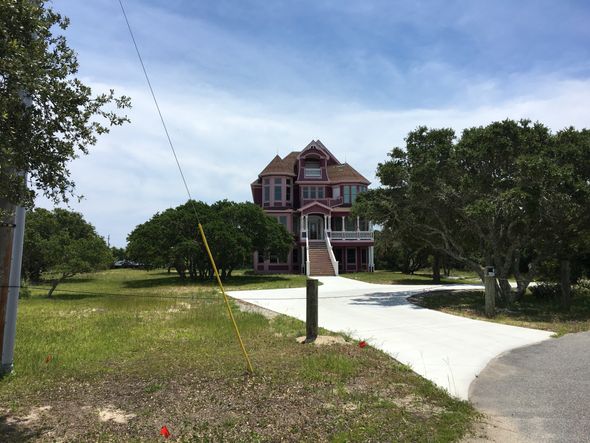
The “Princess House” from the driveway.
On my way back to the Harbor from stumbling upon the Princess House I made a turn down a different street, that also turned out to be a dead end. There, towards the end, in the shade of a crop of trees was a hammock, and a dog with a frisbee. I stopped to watch the dog. The dog suddenly jumped into the hammock, waking a young woman. She rose from the hammock slowly, slightly unbalanced. The dog dropped the frisbee at her feet, but she didn’t move. Her back was to me. She pressed the edge of her jean-skirt towards her knees and stood there, in the shade, barely moving. She placed her hands on her hips, and the dog ran off.
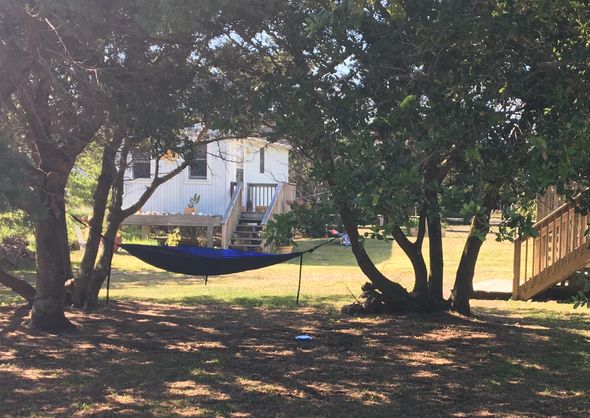
Hammock between the trees.
I put my feet back on the pedals of my bicycle, and rode towards the rest of Avon, the tourist part that resided on the other side of the canal. As I made the turn back towards Harbor Road I caught a faded street sign from the corner of my eye, but didn’t put to much thought to it. I think it read, “SMITH.”
—–
End.
Note: Big thanks to the great people of Avon, NC for their warm welcome and genuine spirit. The Southern part of the Outer Banks, especially Hatteras Island, is incredibly unique. You are on a narrow island, 20+ miles from the coast, that you can drive to. The hours-long drive down to Hatteras Island is serene and surreal; a two-lane road plied down the middle of a 1/4 wide (at most) spit of a series of Islands and bridges. I hope to return soon.